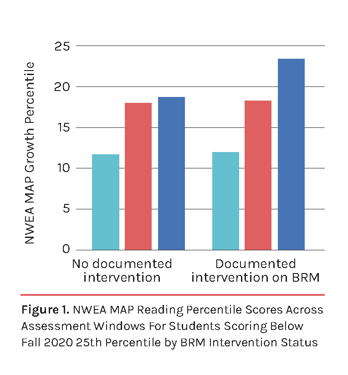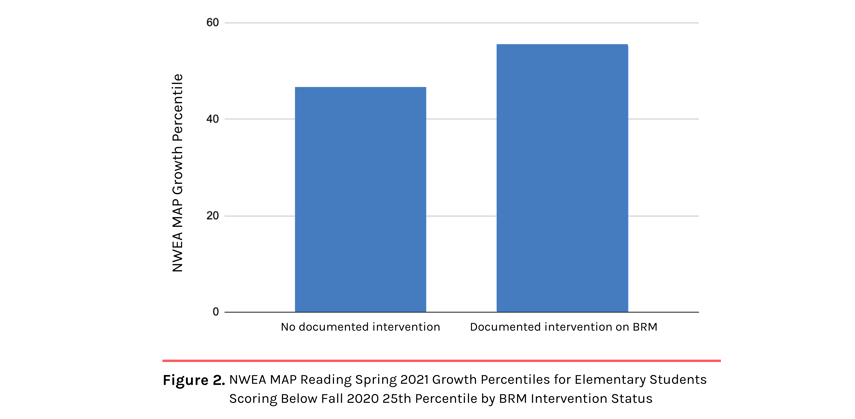Studying Success in MTSS Implementation and Academic Outcomes During the Pandemic Years: Four School District Case Studies
Following the beginning of the COVID-19 pandemic in 2020, schools faced several challenges as they dealt with the transition to remote learning as well as the trauma, increased isolation, and learning losses experienced by students. We identified four district partners who were eager to improve their Multi-Tiered System of Supports (MTSS) practice in order to better support their students during this difficult time. Our team was interested in understanding if districts were able to implement the core components of a successful MTSS practice during the pandemic years and if their use of the Branching Minds platform was associated with growth in student achievement.
The following case study highlights how Sidney City Schools leveraged the BRM platform to identify students needing additional support, use data to guide decision-making and problem-solving, and develop targeted intervention plans using evidence-based interventions and supports. The results also show significant gains in Reading and Math performance for students supported with intervention plans through the BRM platform. Below we discuss Sidney City School's successes and plans for further developing their MTSS practice. (The other case studies are linked below.)
|
|
Sidney City Schools, OH |
AT A GLANCE |
|
Introduction and Implementation
When Sidney City Schools started their partnership with Branching Minds (BRM) they were essentially starting at “ground zero” in terms of their Multi-Tiered System of Supports (MTSS) practice. Up until this point teachers had been using a large variation of intervention programs and strategies; some evidence-based and some not. Their short-term goals included rolling out the platform across all elementary schools and using it primarily to improve their process and practice for developing intervention plans for reading.
Across the 2020-2021 school year, the district saw the following implementation-based outcomes across all elementary schools:
| Tier levels of support were identified for 95% of elementary students, based on NWEA MAP assessment for reading and math assessments |
|
| 91% of staff members engaged with the platform; staff were using the platform to develop and log intervention plans, enter progress monitoring data, resolve goals, and log family communication |
|
| 44% of students had an active plan, including a goal, intervention, and progress monitoring assessment |
|
| 90%+ activities on the platform were resolved, indicating a high fidelity of implementation |
|
| 80% of goals were progress monitored using EasyCBM, a nationally normed progress monitoring assessment |
Results
To determine the impact of intervention planning on BRM on reading outcomes, student growth on the NWEA MAP reading assessment across the 2020-2021 school year was examined. The analyses included 276 elementary students who scored below the 25th percentile on the assessment at the beginning of the school year and who had subsequent scores at the winter and spring assessment windows.
Students with a documented reading intervention plan on the BRM platform showed increased growth in their reading assessments, compared to students who did not have plans documented (Wilk’s Lambda = .98, F(2,276) = .10, η2 = .02; see Figure 1). This observed trend was strongest between the winter and spring assessment windows. Students who had a documented reading intervention plan during the second half of the school year had a significant increase in their NWEA MAP growth percentile scores (t(277) = -2.06, p = .04, η2 = .02; see Figure 2).

Conclusion and Next Steps
The results show strong platform adoption for Sidney City Schools during their first school year partnering with BRM. For students struggling with reading at the beginning of the school year, having an active intervention plan was associated with improved reading performance across the school year. This was especially evident during the second half of the school year, from the winter to spring assessment windows. Many school districts were still working through the challenges associated with the COVID-19 pandemic across the 2020-2021 school year. In this case, the return to a more typical in-person learning during the second half of the school year could have contributed to the efficacy of documenting plans on the BRM platform.
Given the initial success with the platform, the district plans to expand implementation beyond the early elementary grade levels. They are interested in having more upper elementary and middle school staff receive additional training on how to use the BRM platform and improve their MTSS practice. Another goal is to find more assessment tools that easily integrate with the BRM platform, allowing a more holistic approach to MTSS and using multiple data points to drive decision-making.
-thumb.jpeg)
Make MTSS Easy, Efficient, and Effective With the Branching Minds Web Platform
Transform your district's MTSS solution with personalized intervention plans, powerful collaboration tools, and easy-to-understand reporting. We are more than just a platform, we are a system-level partner.
|
|
|
|
School leaders report improved quality and consistency with the Branching Minds platform. |






